Peppers Ranked by Heat
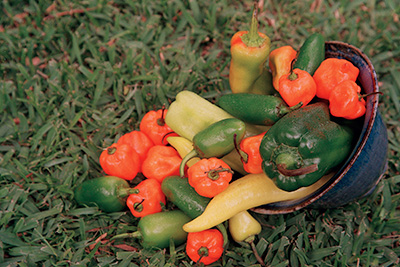
Where does your favorite pepper rank?
Peppers (Capsicum spp.) are a popular vegetable to grow in Florida and with such a wide variety of choices it’s no wonder. Three species of Capsicum produce many of the most common pepper varieties. Capsicum annuum is the most common domesticated species. These peppers can be sweet, mild, or hot. Some of the hottest pepper cultivars in the world belong to the C. chinense species. The third group, C. frutescens, is a much less widely cultivated species, but that doesn’t mean it isn’t worth growing.
The “hotness” of peppers is often measured in Scoville Heat Units (SHU)—a scale invented by Wilbur Scoville—which generally reflects the capsaicinoid content of a pepper. Capsaicinoids are the name given to the class of compounds that make a pepper taste “hot.” So for example bell peppers, which have no heat, have a rating of 0 Scoville units. The following is an abbreviated list of some of the popular peppers that can be grown in Florida, ranked by their heat intensity.
Capsicum annuum
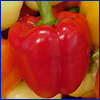
Bell Pepper – 0 SHU
Bell peppers are very common. They are often used fresh in salads and sandwiches, eaten as a snack, or used as a cooked vegetable in meat, rice, or stir fry dishes.
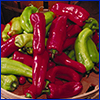
Cubanelle Pepper – About 1,000 SHU
These sweet peppers are also called Cuban pepper or ají cubanela. These peppers are great for frying and cooking in general and are used extensively in cooking in Puerto Rico, Cuba, and the Dominican Republic.
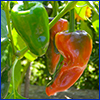
Poblano Pepper – 1,000 to 2,000 SHU
This popular Mexican chili pepper is mildly hot and can be eaten unripe (green) or ripe (red). They produce continuously through the summer. When ripened and dried, these peppers are called “ancho”. (Photo by Melinda Stuart, some rights reserved.)
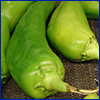
Anaheim Pepper – 1,000 to 5,000 SHU
This vigorous bushy plant produces green fruits that turn maroon when ripe. Fruits have a slightly tapered shape and can be used ripe or unripe. They can be consumed fresh or dried and used as a powder. (Photo by Forest and Kim Starr, some rights reserved.)
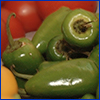
Jalapeño Pepper – 2,000 to 8,000 SHU
These peppers are commonly used in salads, salsa, and Mexican food. Jalapeño peppers are well-liked for their heat, which isn’t considered to be overwhelming. These peppers start green and turn red once mature. Chipotle chilies are ripe jalapeño chilies that have been wood smoked.
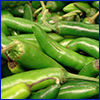
Serrano Pepper – 10,000 to 25,000 SHU
This chili pepper originated in the mountainous regions of Mexican states Puebla and Hidalgo. While it is similar in appearance to the jalapeño pepper it is much hotter. These peppers are usually eaten raw, and are often used to make pico de gallo and salsa.
(Photo by Forest and Kim Starr, some rights reserved.)
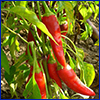
Cayenne Pepper – 25,000 to 50,000 SHU
This pepper is named for the city of Cayenne in French Guiana and is also known as Guinea spice, cow-horn pepper, aleva, bird pepper, or red pepper (especially in powdered form). Used to flavor dishes, it is usually dried and used as ground powder or dried flakes. (Photo by H. Zell. This file is licensed under the Creative Commons Attribution-Share Alike 3.0)
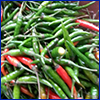
Thai Pepper – 50,000 to 100,000 SHU
This pepper is also called bird’s eye chili or bird’s chili. It is often confused with cultivars derived from C. frutescens because of its similar appearance. Originally from Mexico, Central America, or South America, this pepper is now commonly grown in South and Southeast Asia. Plants can grow up to 6 feet tall and feature small, tapering fruits that are about an inch long. (Photo: Qingren Wang, UF/IFAS)
Capsicum chinense
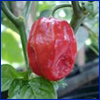
Cachucha Pepper – 500 to 1,500 SHU
These peppers are also called aji dulce. They are native to the Caribbean region and are similar in appearance to a habanero pepper. (Photo: UF/IFAS, Reimer Seed)

Habanero Pepper – 100,000 to 350,000 SHU
These peppers are thought to have originated in Peru then spread through Mexico and on to other countries across the world. Habanero peppers are popularly used in hot sauces and spicy foods. (Photo: UF/IFAS)
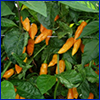
Datil Pepper – 100,000 to 3000,000 SHU
These peppers are well-known in St. Augustine where they are said to have been brought to Florida by Minorcans. Datil peppers are relatively small and bright yellow-orange in color. The flavor of these peppers is unique in that it has a sweet, fruity tang coupled with its spiciness. (Photo: UF/IFAS)
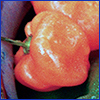
Scotch Bonnet Pepper – 100,000 to 350,000 SHU
This pepper’s name comes from its resemblance to the Scottish “tam o’ shanter” hat. However, this pepper is found primarily in the Caribbean, Guyana, and the Maldives where it’s used in regional cooking, particularly Caribbean jerk sauce and marinades. (Photo: UF/IFAS)
Capsicum frutescens

Tabasco Pepper – 30,000 to 50,000 SHU
This pepper is named after the Mexican state Tabasco. Fruits of this species grow a little differently than other peppers; they remain upright when they mature instead of hanging down from their stems. Plants can grow up to about 5 feet tall with a bushy growth.
Hybrid
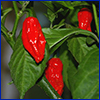
Bhut Jolokia – The third hottest pepper in the world at 1,041,427 SHU
The bhut jolokia pepper is an interspecies hybrid, mostly Capsicum chinense with Capsicum frutescens. It’s also known as naga jolokia, bih jolokia, ghost pepper, ghost chili pepper, red naha chili, and ghost chili. These peppers were cultivated in the Indian state of Assam and named for the Bhutia tribe. These peppers are used fresh or dried as an ingredient in spicy food.
